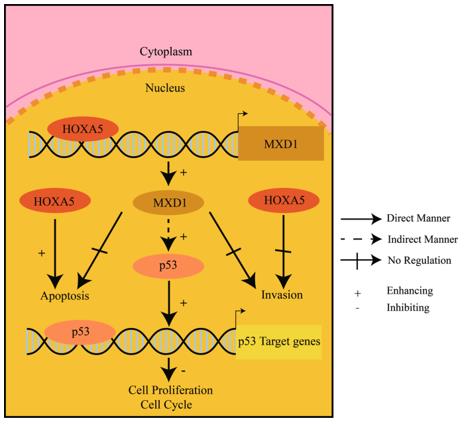What is HOXA5 Protein
The HOXA5 protein, officially known as Homeobox A5, is a crucial member of the homeobox gene family. This family is instrumental in embryonic development, where it plays a pivotal role in the regulation of pattern formation. Also referred to as HOX-1.13, HOXA5 is a segmental gene that encodes a transcription factor. Its synonyms include Hox-1E and Hox1.8, reflecting the gene's various aliases in scientific literature.
HOXA5 Protein Structural Characteristics and Classification
Structurally, HOXA5 exhibits the characteristic homeodomain, a conserved sequence of 60 amino acids that functions as a DNA-binding domain. This protein is classified under the Antennapedia homeobox class, which is further categorized into the Hox family. Recent research advances in understanding HOXA5's structural characteristics have shed light on its intricate role in orchestrating gene expression during development.
HOXA5 Biological Functions and Molecular Mechanisms
The biological functions of HOXA5 are diverse and multifaceted. As a transcription factor, HOXA5 primarily acts as a regulator of gene expression. Its involvement in embryonic development is particularly noteworthy, where it governs the formation of body structures and ensures proper tissue differentiation. In adults, HOXA5 continues to exert its influence by participating in the maintenance of tissue homeostasis.
Molecular mechanisms governed by HOXA5 include its interaction with specific DNA sequences, known as HOX binding sites, within target genes. Through these interactions, HOXA5 modulates the transcriptional activity of downstream genes, thereby influencing critical cellular processes. Moreover, research has illuminated the role of HOXA5 in angiogenesis, apoptosis, and cell cycle regulation, highlighting its far-reaching impact on cellular physiology.

Figure 1. A diagram illustrates the roles of HOXA5 and MXD1 in the pathogenesis of ECCA. (Xiong F, et al., 2022)
HOXA5 Related Signaling Pathway
The signal pathway associated with HOXA5 is a complex network of interactions that regulate its expression and activity. Notably, the Wnt signaling pathway has emerged as a key player in modulating HOXA5 levels. Activation of Wnt signaling has been shown to influence the expression of HOXA5, thereby impacting downstream cellular processes.
Furthermore, interactions with other signaling pathways, such as the Notch and Hedgehog pathways, contribute to the intricate regulation of HOXA5. Decoding these signal pathways provides valuable insights into the broader regulatory network governing HOXA5 and its downstream effects on cellular function.
HOXA5 Related Diseases
While HOXA5 is pivotal for normal development and tissue homeostasis, aberrations in its expression or function have been implicated in various diseases. Notably, dysregulation of HOXA5 has been associated with certain types of cancer, including breast cancer and lung cancer. Altered expression levels of HOXA5 have been observed in tumor tissues, indicating its potential role as a diagnostic marker.
In addition to cancer, HOXA5 has been linked to cardiovascular diseases. Research suggests that imbalances in HOXA5 expression may contribute to vascular dysfunction, underscoring its relevance in cardiovascular pathophysiology. Exploring the intricate relationship between HOXA5 and disease states opens new avenues for targeted therapies and diagnostic strategies.
HOXA5's Applications in Biomedicine
The unique properties of HOXA5 make it a promising candidate for applications in biomedical research. Its role in cancer, for instance, positions HOXA5 as a potential biomarker for early detection and prognosis assessment. Diagnostic developments leveraging HOXA5 could revolutionize cancer screening, enabling more accurate and timely interventions.
In the realm of vaccine development, understanding the molecular mechanisms of HOXA5 opens avenues for targeting specific pathways associated with diseases. This knowledge could inform the design of therapeutic vaccines, aiming to harness the body's immune system to combat conditions where HOXA5 dysregulation is implicated.
Moreover, the therapeutic potential of HOXA5 extends to targeted drug development. Modulating HOXA5 expression or activity may represent a novel strategy for treating diseases with aberrant HOXA5 function. The prospect of precision medicine, guided by insights into the molecular intricacies of HOXA5, holds promise for more effective and tailored therapeutic interventions.
Recommended Products
| Cat.No. | Product Name | Species | Source (Host) | Tag |
|---|---|---|---|---|
| HOXA5-067H | Recombinant Human HOXA5 Protein, GST-HIS-tagged | Human | E.coli | GST/His |
| HOXA5-4946H | Recombinant Human HOXA5 Protein, GST-tagged | Human | Wheat Germ | GST |
| HOXA5-29376TH | Recombinant Human HOXA5 | Human | Wheat Germ | N/A |
| HOXA5-01H | Recombinant Human HOXA5 Protein, His-tagged | Human | E.coli | His |
| HOXA5-301240H | Recombinant Human HOXA5 protein, GST-tagged | Human | E.coli | GST |
| HOXA5-2777H | Recombinant Human HOXA5 protein, His-tagged | Human | E.coli | His |
| HOXA5-3711HF | Recombinant Full Length Human HOXA5 Protein, GST-tagged | Human | In Vitro Cell Free System | GST |
| HOXA5-7791M | Recombinant Mouse HOXA5 Protein | Mouse | Mammalian Cell | His |
| HOXA5-4281M | Recombinant Mouse HOXA5 Protein, His (Fc)-Avi-tagged | Mouse | HEK293 | His (Fc)-Avi |
Reference
- Xiong F, et al. HOXA5 inhibits the proliferation of extrahepatic cholangiocarcinoma cells by enhancing MXD1 expression and activating the p53 pathway. Cell Death & Disease. 2022, 13(9): 829.

